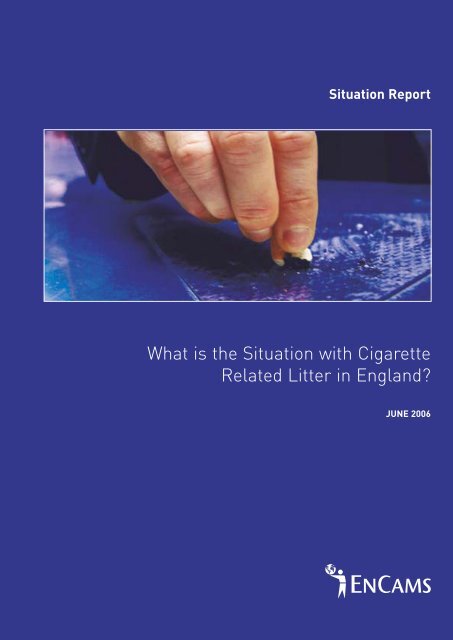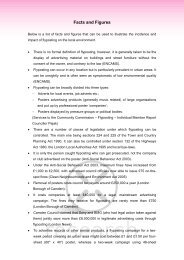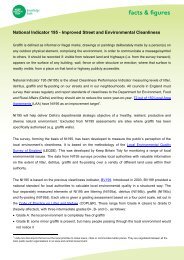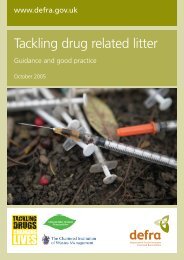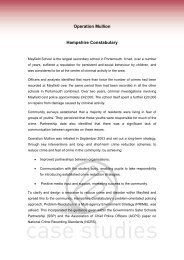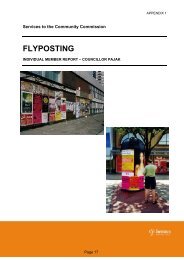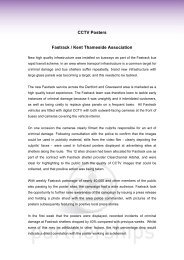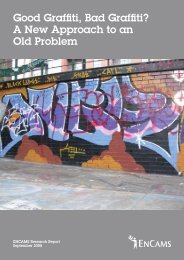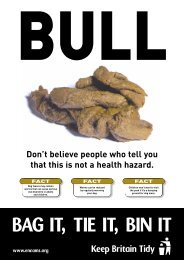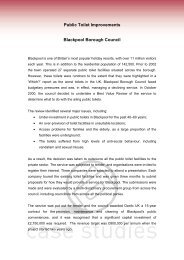What is the Situation with Cigarette Related Litter ... - Keep Britain Tidy
What is the Situation with Cigarette Related Litter ... - Keep Britain Tidy
What is the Situation with Cigarette Related Litter ... - Keep Britain Tidy
- No tags were found...
You also want an ePaper? Increase the reach of your titles
YUMPU automatically turns print PDFs into web optimized ePapers that Google loves.
Table of Contents1 Foreward ...................................................................................................................................12 Executive Summary .................................................................................................................22.1 <strong>What</strong> <strong>is</strong> <strong>the</strong> extent of cigarette related litter...................................................................22.2 Identified solutions to reduce cigarette related litter....................................................32.3 Conclusions / Recommendations.....................................................................................43 Introduction...............................................................................................................................54 Background ..............................................................................................................................64.1 <strong>What</strong> are cigarettes?..........................................................................................................64.2 Consumption Profile ............................................................................................................75 The Problem ............................................................................................................................105.1 About cigarette related litter ..........................................................................................105.2 Where does CRL occur? ..................................................................................................115.3 Why does CRL occur? ......................................................................................................115.4 <strong>What</strong> <strong>is</strong> <strong>the</strong> impact of CRL? .............................................................................................135.5 <strong>Cigarette</strong> <strong>Litter</strong> Monitoring ...............................................................................................176 Identified Solutions .................................................................................................................206.1 Education ...........................................................................................................................206.2 Cleaning and Ashtrays .....................................................................................................246.3 Leg<strong>is</strong>lation ...........................................................................................................................296.4 International Management Models ...............................................................................317 Conclusion and Recommendations...................................................................................337.1 Research and monitoring ................................................................................................337.2 Education and Communication.....................................................................................337.3 Ashtrays / Infrastructure ....................................................................................................347.4 Enforcement of leg<strong>is</strong>lation ...............................................................................................347.5 Cleaning .............................................................................................................................34<strong>Situation</strong> Report - Final
1 ForewardBy Alan Woods OBE, Chief Executive, ENCAMSA survey last year by ENCAMS, which runs <strong>the</strong> <strong>Keep</strong> <strong>Britain</strong> <strong>Tidy</strong> Campaign, confirmed<strong>the</strong>re’s one type of litter which defaces our streets far more than any o<strong>the</strong>r. The annualLocal Environmental Quality Survey of England (LEQSE), which ENCAMS carries out onbehalf of <strong>the</strong> Department for Environment Food and Rural Affairs, monitored 12,000 sitesand found 79% were scattered <strong>with</strong> smoking-related litter. Added to th<strong>is</strong>, in 2007 <strong>the</strong>Government plans to introduce a partial ban on smoking in public places. Therefore, it <strong>is</strong>only sensible to acknowledge that England <strong>is</strong> likely to see an increase in cigarette litteron top of an already significant problem, unless action <strong>is</strong> taken.Th<strong>is</strong> type of litter <strong>is</strong> unsightly and difficult to clean up, as <strong>the</strong> small filters fall into grates andcracks in <strong>the</strong> pavement, avoiding detection by normal cleaning processes. <strong>Cigarette</strong>filters are composed of cellulose acetate, a plastic that can take a long time to breakdown and be absorbed back into <strong>the</strong> environment. <strong>Cigarette</strong> litter can even lead totoxins leaking into watercourses which pose a threat to our wildlife.There are various responses to th<strong>is</strong> situation: more street cleansing, better cigarette binprov<strong>is</strong>ion, enforcement through fines and penalties, changing public attitudes tocigarette litter or providing more convenient d<strong>is</strong>posal solutions such as portable ashtrays.All of <strong>the</strong>se could work. But how much better would <strong>the</strong>y work if co-ordinated into aconcerted, focussed effort? I believe th<strong>is</strong> <strong>is</strong> <strong>the</strong> way forward and for that reasonENCAMS has undertaken to establ<strong>is</strong>h a group of stakeholders who share a w<strong>is</strong>h to seeless cigarette litter in <strong>the</strong> environment and to find effective and pro-active ways toachieve that end.Th<strong>is</strong> <strong>Situation</strong> Report <strong>is</strong> a step towards achieving that goal and I greatly welcome it as acomprehensive summary of <strong>the</strong> <strong>is</strong>sues involved, as a document around which to build aconsensus and as a d<strong>is</strong>cussion piece.ENCAMS has evidence that smoking-related litter has increased by 20% in <strong>the</strong> last fouryears. I believe it’s time to reverse that trend. I also believe it can be done. WhenENCAMS ran a campaign earlier th<strong>is</strong> year, it achieved a 35% reduction in cigaretterelated litter in <strong>the</strong> areas targeted. That’s a great result but what lessons can be learnedand how can that success be sustained?Th<strong>is</strong> Report <strong>is</strong> not intended as a static document. We will update and add to it as <strong>the</strong>work progresses. I w<strong>is</strong>h to thank everyone who has supported and contributed to <strong>the</strong>work and I look forward to working <strong>with</strong> you to create cleaner environments for all.<strong>Situation</strong> Report - Final 1
3 Introduction<strong>Cigarette</strong>-related litter <strong>is</strong> <strong>the</strong> most common type of litter found in England. ENCAMS, anenvironmental charity, has recognized <strong>the</strong> need to develop a co-ordinated approachbetween stakeholders to address <strong>the</strong> <strong>is</strong>sue. Th<strong>is</strong> complements <strong>the</strong> ENCAMS cigarettelittering campaign implemented across England in February 2006.Th<strong>is</strong> document aims to ga<strong>the</strong>r all available information about cigarette-related litter inEngland, in relation to:• The extent and impact of <strong>the</strong> problem;• The solutions – education, leg<strong>is</strong>lation and enforcement, ashtrays and cleaning.The ultimate purpose of <strong>the</strong> document <strong>is</strong> to identify ‘what works’ in terms of reducingcigarette-related litter in <strong>the</strong> Engl<strong>is</strong>h context, and to identify gaps in our knowledge andcurrent interventions. Th<strong>is</strong> will help to guide future cigarette-related litter interventions,ensuring that resources are allocated most effectively.Th<strong>is</strong> document <strong>is</strong> open to stakeholder input. It will be supplemented regularly, to includeverifiable information about cigarette related litter <strong>is</strong>sues.<strong>Situation</strong> Report - Final 5
4 BackgroundTh<strong>is</strong> section outlines information about <strong>the</strong> composition of cigarettes and a profile ofsmokers and <strong>the</strong>ir consumption patterns.4.1 <strong>What</strong> are cigarettes?<strong>Cigarette</strong>s are ei<strong>the</strong>r packeted or hand-rolled. ‘Packeted cigarettes’ are <strong>the</strong> mostcommon type consumed in England and are referred to as ‘cigarettes’.4.1.1 Packeted <strong>Cigarette</strong>s (<strong>Cigarette</strong>s)‘Packeted’ cigarettes (i.e cigarettes) are a paper-wrapped cylinder, packed <strong>with</strong>shredded tobacco leaves (cons<strong>is</strong>ting of nicotine) 17 . After <strong>the</strong> tobacco leaves have beendried and cut to make cigarettes, <strong>the</strong>y are treated <strong>with</strong> chemicals and additives,helping to ensure <strong>the</strong> cigarette remains lit, remains mo<strong>is</strong>t and in some cases, to modify<strong>the</strong> flavour of cigarettes 1819 . A filter <strong>is</strong> affixed to one end of <strong>the</strong> cylinder, through which<strong>the</strong> cigarettes <strong>is</strong> smoked after <strong>the</strong> opposite end has been ignited. The smoulderingcigarette <strong>is</strong> inhaled until <strong>the</strong> cylinder portion of <strong>the</strong> cigarette has been consumed,leaving <strong>the</strong> filter (or <strong>the</strong> cigarette ‘butt’) as a waste product.The filter <strong>is</strong> made from a bundle of syn<strong>the</strong>tic fibres called cellulose acetate 20 . Celluloseacetate <strong>is</strong> made from <strong>the</strong> chemical modification of cellulose to form a type of plastic 21 .Filters are made specifically to capture both nicotine (which acts as a stimulant on <strong>the</strong>central nervous system 22 , increasing <strong>the</strong> heart rate, reducing appetite and increasingalertness 23 ) and tar. Tar refers to hundreds of chemicals including arsenic, mercury andlead 24 .Used cigarettes filters are commonly known as cigarette ‘butts’ or cigarette ‘ends’.4.1.2 Hand rolled cigarettesHand rolled cigarettes are made from <strong>the</strong> same components as packeted cigarettes,however, <strong>the</strong> components (i.e loose tobacco, filters and cigarette papers) arepurchased separately and are assembled by <strong>the</strong> consumer.The overwhelming majority of UK smokers (73%) consume packeted cigarettes only. 18%of smokers consume only hand-rolled cigarettes and <strong>the</strong> remaining 9% consume bothpacketed and hand rolled cigarettes. Fur<strong>the</strong>rmore, men are almost twice as likely tosmoke hand rolled cigarettes as women 25 .17 Wikipedia (2006) http://en.wikipedia.org/wiki/<strong>Cigarette</strong>18 Pers comm. (10 July 2006) Nicky Donnelly, Brit<strong>is</strong>h American Tobacco19 ENCAMS Policy Statement, <strong>Cigarette</strong> related litter20 Reg<strong>is</strong>ter, K (2000) <strong>Cigarette</strong> Butts as <strong>Litter</strong>, Toxic as Well as Ugly underwater Natural<strong>is</strong>t, Bulletin of <strong>the</strong>American Littoral Society, 25:221 ibid22 Pers comm. (10 July 2006) Nicky Donnelly, Brit<strong>is</strong>h American Tobacco23 Wikipedia (March 2006) http://en.wikipedia.org/wiki/Nicotine24 ibid25 Lader, D and Goddard, E (2004) Smoking related behaviour and attitudes Office of National Stat<strong>is</strong>tics<strong>Situation</strong> Report - Final 6
4.1.3 CigarsA cigar <strong>is</strong> a roll of dried and fermented tobacco, one end of which <strong>is</strong> lit so that <strong>the</strong> smoke<strong>is</strong> drawn into <strong>the</strong> mouth through <strong>the</strong> o<strong>the</strong>r end. Cigars are larger and more potent thancigarettes. Consumption rates of cigars are lower than cigarettes, perhaps due to <strong>the</strong>iravailability, cost, potency and perhaps because <strong>the</strong>y tend to be smoked as a ritual or tomark an occasion 26 . The remains of a consumed cigar should also not be littered,however, <strong>the</strong>y are not as common as cigarette butts and are <strong>the</strong>refore not <strong>the</strong> focus ofth<strong>is</strong> project.4.2 Consumption ProfileIt <strong>is</strong> estimated that 70 billion cigarettes were consumed in <strong>the</strong> United Kingdom in 2004 27 ,equating to 200 million cigarettes per day.4.2.1 Tobacco manufacturersA number of tobacco manufacturers are represented in <strong>the</strong> United Kingdom, dominatedby Gallaher, Imperial Tobacco, and to a lesser extent, Rothmans UK 28 . Brit<strong>is</strong>h AmericanTobacco UK Ltd <strong>is</strong> also based in England, and while it manufactures tobacco products inhere, it sells almost all of <strong>the</strong>m overseas. These organizations, (along <strong>with</strong> Philip Morr<strong>is</strong> Ltd)are members of <strong>the</strong> Tobacco Manufacturers Association (TMA) which ‘represents <strong>the</strong>views of its principal member companies and provides factual information on behalf of<strong>the</strong> UK industry as a whole’ 29 .4.2.2 Who are smokers?One quarter of <strong>the</strong> UK adult population are smokers 30 . Smoking rates vary by region andby socio-economic group and by age.A greater proportion of men (26%) smoke than women (23%). Overall, smoking rateshave declined dramatically in <strong>the</strong> UK since 1974, when <strong>the</strong> rate was 45%. Since 2000,<strong>the</strong>re has been no stat<strong>is</strong>tically significant reduction in smoking 31 .The prevalence of smoking reduces <strong>with</strong> age. Smoking prevalence <strong>is</strong> highest in peopleaged between 20-24 years, 32% of whom are smokers. Smoking prevalence <strong>is</strong> lowest inpeople aged over 60, 14% of whom are smokers 32 .Smoking rates vary slightly between regions of England. The North East, North West, andYorkshire and <strong>the</strong> Humber regions have <strong>the</strong> greatest proportion of smokers (29%-28%)compared to <strong>the</strong> rest of England. London and <strong>the</strong> South East had <strong>the</strong> lowest proportionof smokers <strong>with</strong> 22% of <strong>the</strong> population smoking. The proportion of smokers in all regions <strong>is</strong>shown in Table 1.Table 1: Proportion of smokers by region in England (2004)26 Wikipedia (2006) Cigars, http://en.wikipedia.org/wiki/Cigar27 Tobacco Manufacturers Association, http://www.<strong>the</strong>-tma.org.uk.28 Tobacco Control Country Profiles (second edition, 2003) Shafey, O, Dolwick, S, Guindon, G.E (eds) (marketshare estimates are from 2001)29 The Tobacco Manufacturers Association, http://www.<strong>the</strong>tma.org.uk/30 Office of National Stat<strong>is</strong>tics (2005) General Household Survey 2004-05, www.stat<strong>is</strong>tics.gov.uk/ghs31 ibid32 ibid<strong>Situation</strong> Report - Final 7
Region Proportion of smokers (%)North East 29North West 28Yorkshire and <strong>the</strong> Humber 28East Midlands 27East of England 24West Midlands 23South West 23London 22South East 22Smoking rates also seemed to be linked to socio-economic groups. The prevalence ofsmoking <strong>is</strong> higher in those people who undertake routine and manual employment (31%of whom smoke). They consume an average of 15 cigarettes per day. The prevalence ofsmoking by those in intermediate employment (eg small employers and self employed) <strong>is</strong>less, at 23% (and <strong>the</strong>y smoke an average of 14 cigarettes per day). Finally, <strong>the</strong>prevalence of smoking by those in managerial and professional employment <strong>is</strong> <strong>the</strong>lowest at 18% (and <strong>the</strong>y smoke an average of 13 cigarettes per day).In summary, a typical smoker in England <strong>is</strong> likely to:• Live in <strong>the</strong> North East or North West of England;• Be a male;• Be aged between 16-44;• Consume packaged cigarettes (as opposed to hand rolled);• Consume less than 20 cigarettes per day; and• Work in routine or manual employment.4.2.3 Where do smokers consume cigarettes?Research undertaken on behalf of ENCAMS shows that smokers modify <strong>the</strong>ir smokingbehaviour according to who <strong>the</strong>y are <strong>with</strong> and what <strong>the</strong>y are doing 33 . Smokers are morelikely to smoke if <strong>the</strong>y are around o<strong>the</strong>r smokers, or if <strong>the</strong>y are drinking alcohol.Common locations for smoking and <strong>the</strong> reasons for choosing <strong>the</strong>se locations are:• Home - Smokers modified <strong>the</strong>ir behaviour when at home, restricting <strong>the</strong>irsmoking to certain parts of <strong>the</strong>ir prem<strong>is</strong>es.33 ENCAMS (Sept 2005) <strong>Cigarette</strong> related litter, Stage 2 Debrief<strong>Situation</strong> Report - Final 8
• Bars/clubs/restaurants - when drinking alcohol;• Work – Smokers also stated that <strong>the</strong>y tended to smoke at work in order to get abreak from work, or to socialize <strong>with</strong> o<strong>the</strong>r smokers (eg in <strong>the</strong> smoking room).• Out of doors – more men than women smoke out of doors, as women are moreself conscious about it 34 .About half of <strong>the</strong>se smoking locations are both ‘away from home’ and outdoors. It <strong>is</strong><strong>the</strong>se locations where smoking-related litter <strong>is</strong> a concern. With <strong>the</strong> introduction ofsmoking bans in 2007, <strong>the</strong> proportion of away from home, outdoor smoking locations willincrease.34 ibid<strong>Situation</strong> Report - Final 9
5 The ProblemThe extent and impact of cigarette related litter <strong>is</strong> described in fur<strong>the</strong>r detail below.5.1 About cigarette related litter<strong>Cigarette</strong> related litter (also known as smoking related litter) refers to a range of itemsthat are incorrectly d<strong>is</strong>posed of through <strong>the</strong> act of smoking. These items and <strong>the</strong>ircomposition are:• <strong>Cigarette</strong> butts and cigar ends–cigarette butts are made of cellulose acetate(plastic) and cons<strong>is</strong>t of trapped tar and some smoke particles leftover from <strong>the</strong>inhaled smoke. Cigar ends are less common and <strong>the</strong>y also contain remnants oftobacco.• <strong>Cigarette</strong> box packaging – cons<strong>is</strong>ting of cardboard cigarette boxes, plasticwrappers and foil inserts.• Ignition source – i.e, wooden matches and plastic lighters.It <strong>is</strong> safe to assume that cigarette butts should be <strong>the</strong> focus of future cigarette-relatedlitter interventions. Th<strong>is</strong> <strong>is</strong> not only due to <strong>the</strong>ir vast quantity, but also due to <strong>the</strong>significance of <strong>the</strong>ir impacts (which are detailed in future sections of th<strong>is</strong> document)compared to o<strong>the</strong>r cigarette related litter items, such as cardboard packaging.5.1.1 How many cigarette butts are littered?It <strong>is</strong> impossible to know <strong>with</strong> certainty <strong>the</strong> exact number of littered cigarette butts on <strong>the</strong>ground across England, due to differing cleaning regimes, wea<strong>the</strong>r conditions, andaccumulated litter.Many publications quote that 200 million cigarette butts are ‘thrown away’ in <strong>the</strong> UKwhich could be m<strong>is</strong>interpreted as an assumption that all of <strong>the</strong>se butts are littered. Th<strong>is</strong> <strong>is</strong>not <strong>the</strong> case. In fact, 200 million cigarettes are consumed every day in <strong>the</strong> UK (asdescribed in a previous section), and it <strong>is</strong> unclear how many of <strong>the</strong>se butts are littered inoutdoor settings.Probably <strong>the</strong> best indication of <strong>the</strong> extent of cigarette related litter in <strong>the</strong> environment <strong>is</strong>from <strong>the</strong> work undertaken by ENCAMS, which shows that cigarette related litter <strong>is</strong> presenton 79% of streets 35 . Th<strong>is</strong> figure was arrived at using rigorous survey protocols and qualityprocedures. Fur<strong>the</strong>r, <strong>the</strong> data <strong>is</strong> collected quarterly and reported annually, providingmore reliable information than a one-off sample of litter composition.Several o<strong>the</strong>r studies have been conducted which provide an indication of <strong>the</strong>composition of litter in <strong>the</strong> environment. ENCAMS undertook a litter sample study onbehalf of INCPEN, finding that cigarette butts compr<strong>is</strong>e of 32% of all litter, making <strong>the</strong>m<strong>the</strong> second highest type of litter by volume (after chewing gum) in England 36 . Theseresults were arrived at through litter counts at 30 sample sites (transects).35 ENCAMS (2005) LEQSE 2004-0536 ENCAMS (Oct 2004) INCPEN <strong>Litter</strong> Survey of England, INCPEN<strong>Situation</strong> Report - Final 10
Finally, during <strong>the</strong> Marine Conservation Society’s Beachwatch 2003 beach litter survey, atotal of 14,659 cigarette ends were found on 244 beaches around <strong>the</strong> UK. An average108.7 cigarette ends were found for each kilometre of beach surveyed, equivalent toone every 10 metres, an increase of 25% from Beachwatch 2002 (86.7 per km) 37 .5.1.2 How much do littered butts weigh?Given <strong>the</strong> uncertainty surrounding <strong>the</strong> actual number of littered cigarette butts, itlogically follows that <strong>the</strong> actual weight of all littered cigarette butts <strong>is</strong> also impossible toestimate.We know that 1 cigarette butt weighs 0.1701g 38 . Th<strong>is</strong> figure can be used to extrapolate atotal weight if <strong>the</strong> number of littered cigarette butts <strong>is</strong> known.It <strong>is</strong> commonly stated that 122 tonnes of cigarette related litter <strong>is</strong> littered every day in <strong>the</strong>UK. However, <strong>the</strong> origin of th<strong>is</strong> figure <strong>is</strong> unclear (pers comm. Fiona Campbell, PolicyDirector ENCAMS) and <strong>the</strong>refore, <strong>the</strong> method of calculation <strong>is</strong> not verifiable at th<strong>is</strong> stage.5.2 Where does CRL occur?<strong>Cigarette</strong> related litter (CRL) occurs in those areas where smokers are most likely tocongregate. They include <strong>the</strong> areas outside of:• industrial warehouses / units;• retail areas 39 ;• offices; and• transport facilities 40 .5.3 Why does CRL occur?<strong>Cigarette</strong> related litter occurs largely as a result of smokers inappropriately d<strong>is</strong>posing ofcigarette butts. (Clearly, inappropriate d<strong>is</strong>posal refers to smokers dropping cigarettebutts on <strong>the</strong> ground, but it should also be noted that placing cigarette butts on <strong>the</strong> rim ofbins (where <strong>the</strong>y can be blown onto <strong>the</strong> ground), and failing to extingu<strong>is</strong>h a cigarettebutt before placing it into litter bins or ashtrays (causing a fire r<strong>is</strong>k) are also inappropriated<strong>is</strong>posal methods 41 ).<strong>Cigarette</strong> littering behaviour <strong>is</strong> driven by <strong>the</strong> attitudes and knowledge of smokers, and <strong>is</strong>influenced by <strong>the</strong>ir social and environmental context.37 Marine Conservation Society (Aug 2004) <strong>Cigarette</strong> <strong>Litter</strong> on Beaches – Marine Conservation SocietyStatement38 Reg<strong>is</strong>ter, K (2000) <strong>Cigarette</strong> Butts as <strong>Litter</strong>, Toxic as Well as Ugly underwater Natural<strong>is</strong>t, Bulletin of <strong>the</strong> AmericanLittoral Society, 25:239 ENCAMS (2005) LEQSE 2004-200540 Defra (1999) Environmental Protection Act 1990, Code of Practice for <strong>Litter</strong> and Refuse41 Hobart City Council (2004), <strong>Cigarette</strong> Butt Reduction Project for Hobart’s CBD, www.buttlitteringtrust.org<strong>Situation</strong> Report - Final 11
5.3.1 Attitudes and knowledgeENCAMS have undertaken litter segmentation research, in order to understand <strong>the</strong>community’s attitude about littering and drivers behind littering behaviour 42 .Some aspects of ENCAMS’ research demonstrated <strong>the</strong> attitudes or beliefs of smokers inrelation to <strong>the</strong> practice of smoking and littering. The trends from th<strong>is</strong> research are:• <strong>Litter</strong>ing cigarette butts <strong>is</strong> a social norm – smokers do not expect retribution fromei<strong>the</strong>r smokers or non-smokers 43 . Th<strong>is</strong> <strong>is</strong> supported by research which showedthat 82% of people in Ireland would do nothing if <strong>the</strong>y saw a smoker ‘dump acigarette butt’ 44 . In a survey conducted in England, 67% of people had neverpointed out to a smoker that <strong>the</strong>y have dropped a cigarette butt 45 .• <strong>Cigarette</strong> butts are not considered to be litter items – many smokers stated that<strong>the</strong>y treat cigarette butts differently to o<strong>the</strong>r types of litter. While admitting that<strong>the</strong>y would litter a cigarette butt, <strong>the</strong>y would never drop o<strong>the</strong>r types of litter.Some smokers claim that cigarette butts are not as bad as o<strong>the</strong>r types of litter,such as chewing gum. Women tend to feel guiltier about littering cigarette buttsthan men. <strong>Cigarette</strong> butts are considered to be different because of <strong>the</strong>irphysical character<strong>is</strong>tics (<strong>the</strong>y are small, believed to d<strong>is</strong>perse easily and arebelieved to be biodegradable). However, it <strong>is</strong> acknowledged that cigarettebutts are unsightly when en masse.• The need for immediate d<strong>is</strong>posal – Smokers feel that once consumed, cigarettebutts need to be d<strong>is</strong>posed of immediately because of <strong>the</strong>ir uniquecharacter<strong>is</strong>tics i.e, <strong>the</strong>y are perceived to be a fire hazard, smelly and dirty. Theproblems associated <strong>with</strong> d<strong>is</strong>posal mean that smokers are reluctant to carrycigarette butts around <strong>with</strong> <strong>the</strong>m.• Concern about contributing to a fire – Smokers are very conscious of <strong>the</strong> fire r<strong>is</strong>kposed by a lit cigarette. Th<strong>is</strong> can lead to littering as most smokers prefer tostamp out <strong>the</strong> butt on <strong>the</strong> ground to ensure that <strong>the</strong>y are extingu<strong>is</strong>hed 46 .• Some smokers feel guilty about littering butts – most smokers admitted toglancing around to ensure no-one was looking before throwing <strong>the</strong>ir cigarettebutts on <strong>the</strong> ground 47 , suggesting that <strong>the</strong>y are aware that th<strong>is</strong> <strong>is</strong> inappropriatebehaviour.The research also featured drivers behind general littering which include:• Laziness of litterers;• Infrequent emptying of bins; and• Lack of education.42 ENCAMS (Sept 2005) <strong>Cigarette</strong> related litter, Stage 2 Debrief43 ENCAMS (Sept 2005) <strong>Cigarette</strong> related litter, Stage 2 Debrief44 ENCAMS (2005) Cig ban tipped to spark litter cr<strong>is</strong><strong>is</strong>. http://www.encams.org/home/newsdetail.asp45 ENCAMS (Sept 2005) <strong>Cigarette</strong> related litter, Stage 2 Debrief46 ibid47 ibid<strong>Situation</strong> Report - Final 12
5.3.2 Smokers contextSome smokers, mostly older women, claim to never litter cigarette butts 48 . However formost smokers, <strong>the</strong> context / location <strong>the</strong>y are in influences <strong>the</strong> way in which a cigarettebutt <strong>is</strong> d<strong>is</strong>posed.• Draining it - If walking on <strong>the</strong> street, many smokers will aim <strong>the</strong>ir littered buttstoward <strong>the</strong> drain, as <strong>the</strong>y feel that th<strong>is</strong> <strong>is</strong> more responsible than dumping buttson <strong>the</strong> ground 49 .• In a vehicle - many people feel it <strong>is</strong> impossible to be ‘found out’ in th<strong>is</strong> context 50 ,and are <strong>the</strong>refore more likely to litter. Fur<strong>the</strong>rmore, most smokers said that <strong>the</strong>ythrew cigarette butts out of <strong>the</strong> window because it was safer and because of<strong>the</strong> offensive smell of a full ashtray in <strong>the</strong> confined space of a car 51 .• Dirt = dirt - If a place <strong>is</strong> seen as ‘respectable’ or tidy, <strong>the</strong>n smokers are less likelyto litter <strong>the</strong>re 52 .• Availability and suitability of infrastructure – smokers admitted that if an ashtraywas readily available <strong>the</strong>y would use it, but <strong>the</strong>y would not go far to seek oneout 53 . Research from Australia suggests that smokers will not walk to outdoorashtrays that are more than 12m away 54 . Fur<strong>the</strong>rmore, smokers preferreddedicated ashtrays <strong>with</strong> a good design that enabled smokers’ hands to remainclean 55 .• Bars/clubs – cigarette litter <strong>is</strong> accepted in th<strong>is</strong> environment 56 .5.4 <strong>What</strong> <strong>is</strong> <strong>the</strong> impact of CRL?<strong>Cigarette</strong> related litter has environmental, economic and social impacts.5.4.1 Environmental impacts<strong>Cigarette</strong> litter pers<strong>is</strong>ts in <strong>the</strong> environment, harming animals, impacting water quality andposing a fire r<strong>is</strong>k.5.4.1.1 Water quality<strong>Cigarette</strong> butts are easily carried into watercourses after being d<strong>is</strong>charged throughstormwater systems, because <strong>the</strong>y are small and lightweight.When in water, chemicals <strong>the</strong> cigarette butt was designed to trap can leach out 57 . Thetoxicity of cigarette butts on aquatic ecosystems has been tested in <strong>the</strong> US and Australia48 ENCAMS (Sept 2005) <strong>Cigarette</strong> related litter, Stage 2 Debrief49 ibid50 ENCAMS, (2001) <strong>Litter</strong> Segmentation Study Knowledge Bank51 ENCAMS (Sept 2005) <strong>Cigarette</strong> related litter, Stage 2 Debrief52 ENCAMS (2001), <strong>Litter</strong> Segmentation Study, Knowledge Bank53 ENCAMS (Sept 2005) <strong>Cigarette</strong> related litter, Stage 2 Debrief54 BIEC & Community Change Pty Ltd, (2001), <strong>Litter</strong>ing Behaviour Study III, Measuring environmentally desirablechange in Australia. BIEC, Sydney.55 ENCAMS (Sept 2005) <strong>Cigarette</strong> related litter, Stage 2 Debrief56 ibid57 Ager, O (Sept 2005) Marine and Coastal <strong>Litter</strong> The Marine Biological Association of <strong>the</strong> United Kingdom<strong>Situation</strong> Report - Final 13
on planktonic animals. Planktonic animals are often used to measure acute toxicity, dueto <strong>the</strong>ir critical position in <strong>the</strong> ecosystem. They transfer energy and organic matter fromalgae to higher consumers.In <strong>the</strong> US, <strong>the</strong> impact of used cigarette butts in freshwater were tested on <strong>the</strong> Daphinamagna (water flea). The tests showed that chemicals in cigarette butts are toxic towater fleas at a level of 1 cigarette butt per 8L of water. Interestingly, <strong>the</strong> leachate from<strong>the</strong> remnant tobacco portion of <strong>the</strong> butt <strong>is</strong> deadlier in smaller portions (because itcontains more tobacco) than <strong>the</strong> leachate from <strong>the</strong> filter portion of <strong>the</strong> butt 58 .In Australia, <strong>the</strong> impact of used cigarette butts in freshwater were undertaken on a similarfreshwater crustacean, <strong>the</strong> Ceriodaphnia cf. dubia and <strong>the</strong> marine bacterium VibrioF<strong>is</strong>cheri. The study found that chemicals leached from <strong>the</strong> cigarette butts after 1 hour ofcontact <strong>with</strong> freshwater, and th<strong>is</strong> pers<strong>is</strong>ted for at least 7 days. It also found that 1cigarette butt per 40L of freshwater were toxic to both <strong>the</strong> crustacean and bacterium.Similarly to <strong>the</strong> US study, <strong>the</strong> remnant tobacco portion of <strong>the</strong> cigarette butt was moretoxic to <strong>the</strong> crustacean. However, both <strong>the</strong> tobacco portion and filter portion of <strong>the</strong>cigarette butt were just as toxic to <strong>the</strong> bacterium 59 .5.4.1.2 Harming animalsAnimals can be harmed by ingesting cigarettes butts through po<strong>is</strong>oning (nicotinetoxicos<strong>is</strong>) and choking.Low doses of ingested nicotine affects <strong>the</strong> central nervous system leading to excitement,tremours, auditory and v<strong>is</strong>ual d<strong>is</strong>turbances, incoordination, weaknesses, twitching andpossible convulsions. Higher doses (eg <strong>the</strong> nicotine in 1-5 cigarettes) result in aprogression of <strong>the</strong> above signs, and can lead to respiratory arrest and death. Ingestionand <strong>the</strong> affects of nicotine toxicos<strong>is</strong> are more common in larger, younger animals such aspuppies, perhaps due to <strong>the</strong>ir more ind<strong>is</strong>criminate eating behaviour. There are fewexamples of smaller animals (such as birds) presenting <strong>with</strong> symptoms of nicotinetoxicos<strong>is</strong>. Th<strong>is</strong> may be because nicotine products are unpalatable, <strong>the</strong>ir stomach’s havea higher pH (and <strong>the</strong>refore nicotine <strong>is</strong> absorbed slower), and smaller animals tend tospontaneously vomit often soon after ingestion of nicotine 60 .There <strong>is</strong> evidence of ingestion (as opposed to nicotine toxicos<strong>is</strong>) particularly in marine life,who m<strong>is</strong>take small plastic pellets for au<strong>the</strong>ntic food. Plastic particles have been found in<strong>the</strong> stomachs of 63 of <strong>the</strong> world’s 250 species of seabirds 61 , and cigarette butts havebeen found in <strong>the</strong> stomachs of sea turtles and o<strong>the</strong>r marine creatures 62 63 . Ingestion <strong>is</strong> aproblem because plastic pellets can clog <strong>the</strong> intestines of <strong>the</strong>se animals resulting instarvation 64 .58 Reg<strong>is</strong>ter, K (2000) <strong>Cigarette</strong> Butts as <strong>Litter</strong>, Toxic as Well as Ugly Underwater Natural<strong>is</strong>t, Bulletin of <strong>the</strong> AmericanLittoral Society 25:259 Warne, MStJ, Patra R, Cole, B, and Lunau B. in prep. Toxicity of cigarette butts and <strong>the</strong>ir constituents to <strong>the</strong>freshwater cladoceran Ceriodaphnia cf. dubia and <strong>the</strong> marine bacterium Vibrio f<strong>is</strong>cheri.60 Nicole C. Hackendahl, and Colin W. Sereda, (March, 2004) The dangers of nicotine ingestion in dogsVeterinary Medicine, pp 218-22461 James, R.B, (April 1999) Solids In Storm Water Runoff, Water Resources Management62 Ager, O (Sept 2005) Marine and Coastal <strong>Litter</strong> The Marine Biological Association of <strong>the</strong> United Kingdom63 EcoRecycle Victoria (1998), <strong>Cigarette</strong> Butt <strong>Litter</strong> www.litter.vic.gov.au64 James, R.B, (April 1999) Solids In Storm Water Runoff, Water Resources Management<strong>Situation</strong> Report - Final 14
The negative impact of litter on animals <strong>is</strong> supported by an ENCAMS study where 95% ofvets reported that <strong>the</strong>y had treated an animal <strong>with</strong> an injury or illness caused by litter 65 .5.4.1.3 Pers<strong>is</strong>ting in <strong>the</strong> environment (Biodegradability)<strong>Cigarette</strong> butts are not readily biodegradable as many smokers believe. <strong>Cigarette</strong> buttsare made of plastic, and research to date shows that biodegradability <strong>is</strong> hugely varied,which seems to be related to <strong>the</strong> environmental conditions to which <strong>the</strong>y are exposed –i.e whe<strong>the</strong>r <strong>the</strong>y are in terrestrial or aquatic environments, and <strong>the</strong>ir exposure to air.Estimates range from a minimum of 1-2 months to a maximum of 15 years.Research by different organizations shows that cigarette butts take <strong>the</strong> following lengthof time to biodegrade:• 1-2 months in aerobic (<strong>with</strong> air) conditions;• 6-9 months in anaerobic (<strong>with</strong>out air) conditions 66 ;• 80% of a cigarette butt degrades in 12 months in a terrestrial environment 67 ;• 1 year in fresh water 68 69 ; and• 3 70 – 15 71 years in sea-water.Research continues into <strong>the</strong> area of biodegradable cigarette filters. One packagingcompany owns a patent to a process for making biodegradable filters made from foodgradestarch. The starch-derived butts supposedly decompose after 2 months.Apparently, fur<strong>the</strong>r research and funding <strong>is</strong> required in order to fully commercial<strong>is</strong>e <strong>the</strong>new filters 72 .It should be considered that <strong>the</strong> promotion of biodegradable filters as a ‘solution’ to <strong>the</strong>problem of cigarette littering sends a mixed message to smokers about takingresponsibility for litter.5.4.1.4 FiresCarelessly littered cigarette butts can contribute to fire. If a butt <strong>is</strong> dropped <strong>with</strong>outbeing extingu<strong>is</strong>hed, it can smoulder for up to 3 hours 73 . There <strong>is</strong> no data available aboutoutdoor fires that may have been caused by carelessly dropped cigarette butts in a65 ENCAMS (2003) Veterinary Surgery Survey – a brief summary66 Victorian <strong>Litter</strong> Action Alliance, (2006) http://www.litter.vic.gov.au/www/html/571-environmentalimpacts.asp,Australia67 Co-operative Centre for Scientific Research Relative to Tobacco (August 2000)http://www.litter.vic.gov.au/www/html/571-environmental-impacts.asp, Australia68 Japan Tobacco Inc, (1996) Tobacco Science Research Laboratoryhttp://www.litter.vic.gov.au/www/html/571-environmental-impacts.asp, Australia69 Victorian <strong>Litter</strong> Action Alliance, (2006) http://www.litter.vic.gov.au/www/html/571-environmentalimpacts.asp,Australia70 ibid71 Marine Conservation Society (Aug 2004) <strong>Cigarette</strong> <strong>Litter</strong> on Beaches – Marine Conservation SocietyStatement http://www.adoptabeach.org.uk/72 Good News Filters Through on Stanelco http://www.stanelco.co.uk/press.html73 Clean Up Australia, (2006) <strong>Cigarette</strong> Butts and <strong>the</strong> Environment, www.cleanup.com.au<strong>Situation</strong> Report - Final 15
public place. The Fire Service does not record <strong>the</strong> source of outdoor fires because <strong>the</strong>yare mostly secondary fires, as opposed to primary fires 74 .In dwellings, cigarettes, cigars and pipes were <strong>the</strong> source of ignition for an average of4,200 fires per year in <strong>the</strong> UK between 1999 - 2003. The majority of <strong>the</strong>se fires werecaused by <strong>the</strong> careless d<strong>is</strong>posal of cigarettes 75 . Lit cigarette butts were a contributingfactor to two of <strong>Britain</strong>’s worst d<strong>is</strong>asters: <strong>the</strong> Bradford City Football fire in which 40 peopledied in 1985, and <strong>the</strong> King’s Cross Underground station fire in 1987 when 31 peopledied 76 .While <strong>the</strong>se are very serious impacts, <strong>the</strong> management of cigarette consumption wasteinside private dwellings and commercial buildings <strong>is</strong> outside of <strong>the</strong> scope of th<strong>is</strong> project,which <strong>is</strong> focusing on outdoor litter in public places.5.4.2 Economic impacts<strong>Cigarette</strong> related litter <strong>is</strong> costly to clean-up. Much of th<strong>is</strong> cost <strong>is</strong> absorbed by LocalAuthorities in <strong>the</strong> form of dedicated cleaning staff (eg answering calls on a telephonehotline, street cleaners). Some indication of th<strong>is</strong> cost <strong>is</strong> reflected in recent research,which shows that <strong>the</strong> clean-up of all types of litter (not just cigarette related litter) costsLocal Authorities an average of £124,155 (2004). It <strong>is</strong> estimated that <strong>the</strong> clean up costs oflitter incurred across all regions in England <strong>is</strong> over £340 million per year 77 .In Australia, most Local Councils spend less than AU$5,000 (approximately £2,080) onspecific cigarette littering initiatives per year 78 .Fur<strong>the</strong>rmore, cigarette butts can also contribute to blocking and flooding drainagesystems, which can be costly to repair.5.4.3 Social impactsHuman health and aes<strong>the</strong>tics can be affected by cigarette related litter.5.4.3.1 Ingestion of cigarette butts by childrenIf cigarette butts are ingested by children, vomiting, gagging and lethargy are likely tooccur as a result of nicotine present in tobacco. More severe symptoms (such as limbjerking and unresponsiveness) occur when larger amounts of nicotine are ingested (i.e byingesting ei<strong>the</strong>r a whole cigarette or three cigarette butts) 79 . It should be noted,however, that in most cases, children are more likely to be exposed to <strong>the</strong>se dangersthrough cigarette consumption waste left around <strong>the</strong> home of smokers (which <strong>is</strong> outside<strong>the</strong> scope of th<strong>is</strong> project) ra<strong>the</strong>r than littered cigarette butts in outdoor settings 80 , so <strong>the</strong>seimpacts should be viewed in that context.74 Pers comm., 10 th February 2005, Lyndsey Avery, Office of <strong>the</strong> Deputy Prime Min<strong>is</strong>ter75 Office of <strong>the</strong> Deputy Prime Min<strong>is</strong>ter (March 2005) Fire Stat<strong>is</strong>tics United Kingdom, 2003, London76 ENCAMS, Cig Bans Tipped to Cause <strong>Litter</strong> Cr<strong>is</strong><strong>is</strong> (Nov 2005)77 ENCAMS, (2004) Local Environment Quality, A Local Authority Perspective78 Butt <strong>Litter</strong>ing Trust (2003) Local Government Butt <strong>Litter</strong>ing Survey, http://www.buttlitteringtrust.org/79 Smolinske SC, Spoerke DG, Spiller SK, Wruk KM, Kulig K, Rumack BH <strong>Cigarette</strong> and nicotine toxicity in childrenHum Toxicol. 1988 Jan;7(1):27-31 Rocky Mountain Po<strong>is</strong>on and Drug Centre80 Novotny, T and Zhao, F (1999) Consumption and Tobacco Waste: ano<strong>the</strong>r externality of tobacco use Tob.Control 8; 75-80<strong>Situation</strong> Report - Final 16
5.4.3.2 Social d<strong>is</strong>amenitySmokers agree that littered cigarette butts do not look good 81 . Fur<strong>the</strong>rmore, as ENCAMShas documented, litter not only lowers <strong>the</strong> aes<strong>the</strong>tics of a locality. The prevalence oflitter, toge<strong>the</strong>r <strong>with</strong> o<strong>the</strong>r environmental crimes, and <strong>the</strong> maintenance of streetinfrastructure, also contributes to our quality of life 82 . Essentially, ‘litter attracts litter’,which can attract o<strong>the</strong>r environmental crimes, sending out a message that people donot care for <strong>the</strong> environment and that it <strong>is</strong> acceptable to litter.5.5 <strong>Cigarette</strong> <strong>Litter</strong> MonitoringMeasuring <strong>the</strong> extent of cigarette litter in <strong>the</strong> environment <strong>is</strong> important in order tounderstand whe<strong>the</strong>r interventions have successfully reduced cigarette related litter.Several monitoring methodologies are described below.5.5.1 The Local Environment Quality Survey of England (LEQSE)Since 2001, <strong>the</strong> extent of cigarette related litter (i.e including cigarette butts, cigarettepackaging and ignition source – <strong>the</strong> majority of which <strong>is</strong> cigarette butts) has beenestimated in England through <strong>the</strong> annual ENCAMS Local Environment Quality Survey ofEngland (LEQSE).The LEQSE measures <strong>the</strong> presence or absence of litter in transects at over 12,000 sitesacross England. It also measures <strong>the</strong> impact of litter and o<strong>the</strong>r anti-social behaviouractivity that affects <strong>the</strong> physical local environment.The latest report showed that cigarette related litter <strong>is</strong> present on 79% of England’sstreets 83 . Th<strong>is</strong> has increased by 16% since measurement began in 2001/02 (Table 2).ENCAMS suspect that th<strong>is</strong> increase <strong>is</strong> related to a noted r<strong>is</strong>e in cigarette butts littered in<strong>the</strong> transects monitored outside of industrial/warehouse/retail sheds. (Which canprobably be attributed to an increase in workplace smoking bans, forcing smokersoutside where <strong>the</strong>re <strong>is</strong> insufficient butt d<strong>is</strong>posal infrastructure).Table 2: Proportion of transects where cigarette related litter <strong>is</strong> presentYearCRLpresent(%)Increasesince 2001/02(%)2004/05 79 162003/04 79 162002/03 60 -32001/02 63 -81 ENCAMS (Sept 2005) <strong>Cigarette</strong> related litter, Stage 2 Debrief82 ENCAMS (2003-04) LEQSE83, ENCAMS (2005) LEQSE 2004-05<strong>Situation</strong> Report - Final 17
5.5.2 <strong>Litter</strong> CountDuring a litter count, <strong>the</strong> amount of litter <strong>is</strong> counted at a site (or in a set area <strong>with</strong>in asite). <strong>Cigarette</strong> litter would be included as part of th<strong>is</strong> survey.Th<strong>is</strong> requires several v<strong>is</strong>its to <strong>the</strong> site. On <strong>the</strong> first v<strong>is</strong>it, litter <strong>is</strong> counted, collected andcategor<strong>is</strong>ed. After a certain period of time (eg one month), <strong>the</strong> site <strong>is</strong> v<strong>is</strong>ited again and<strong>the</strong> same process <strong>is</strong> repeated.Th<strong>is</strong> <strong>is</strong> a comprehensive and reliable way to measure litter levels. It <strong>is</strong> more resourceintensive, however, it provides information on <strong>the</strong> net amount of litter accumulated<strong>with</strong>in a given timeframe. It can also provide information on <strong>the</strong> effectiveness of litteringinterventions.5.5.3 Market researchMarket research can also take place on a broader level <strong>with</strong> a sample of <strong>the</strong> public. Th<strong>is</strong>enables an understanding of general knowledge, attitudes and behaviours of smokersday to day, and not in direct relation to a specific campaign.5.5.4 Attitude and Awareness SurveysSurveys measure <strong>the</strong> attitudes and knowledge of smokers related to a specificcampaign. Face to face surveys mostly occur at a local level eg, in response to a localanti-littering campaign. Th<strong>is</strong> provides an understanding of whe<strong>the</strong>r <strong>the</strong> campaign <strong>is</strong> likelyto have changed <strong>the</strong> littering behaviour of smokers. Th<strong>is</strong> can be flawed, as self reportingof behaviour change <strong>is</strong> often biased, <strong>with</strong> interviewees often telling <strong>the</strong> interviewer what<strong>the</strong>y want to hear. Surveys of th<strong>is</strong> nature often take place face to face, which can beresource intensive. Th<strong>is</strong> type of monitoring has been used extensively in Australian antilitteringprojects run through grants by <strong>the</strong> Butt <strong>Litter</strong>ing Trust and EcoRecycle Victoria. It<strong>is</strong> also being used by ENCAMS for <strong>the</strong> cigarette litter campaign <strong>with</strong> local authorities.5.5.5 <strong>Cigarette</strong> <strong>Litter</strong> Action ScoreThe ‘<strong>Cigarette</strong> <strong>Litter</strong> Action Score’ (CLAS) <strong>is</strong> an observational method owned byAustralian consultants ‘Community Change’. It <strong>is</strong> derived from <strong>the</strong> ‘Clean CommunitiesAssessment Tool’, which measures <strong>the</strong> changes in <strong>the</strong> following four factors that influenced<strong>is</strong>posal actions- context, facilities, attitudes and actions. The CLAS <strong>is</strong> derived from <strong>the</strong>actions component of <strong>the</strong> CCAT, and specifically relates to cigarette butt d<strong>is</strong>posals.The CLAS <strong>is</strong> <strong>the</strong> number of negative d<strong>is</strong>posals (i.e - littering of cigarette butts) as aproportion of total cigarette d<strong>is</strong>posals. The CLAS <strong>is</strong> used to track <strong>the</strong> specific impact ofanti-cigarette littering programs 84 .Since th<strong>is</strong> method <strong>is</strong> owned by <strong>the</strong> consultants, it <strong>is</strong> not used by all stakeholders.5.5.6 Behavioural observationThe behavioural observation monitoring method <strong>is</strong> used to measure <strong>the</strong> litteringbehaviour of smokers before and after an anti-cigarette littering campaign. It has beenused widely on projects funded by <strong>the</strong> Butt <strong>Litter</strong>ing Trust. A large number of observationsneed to be made in order for <strong>the</strong> outcomes to be rigourous.84 Hobart City Council (2004), <strong>Cigarette</strong> Butt Reduction Project for Hobart’s CBD, www.buttlitteringtrust.org<strong>Situation</strong> Report - Final 18
5.5.7 Comments about cigarette litter monitoring methodsTable 3 d<strong>is</strong>plays a matrix of <strong>the</strong> methodologies described above. It highlights that <strong>the</strong>re <strong>is</strong>no single method that measures all aspects of <strong>the</strong> problem. There are several monitoringmethods available that measure <strong>the</strong> attitudes and behaviour of smokers. However, italso highlights that <strong>the</strong>re <strong>is</strong> currently not an accessible, non-resource intensive,repeatable monitoring methodology that takes into account <strong>the</strong> amount of cigarettelitter, and links it to smokers littering behaviour. Th<strong>is</strong> <strong>is</strong> a key challenge that may beaddressed throughout th<strong>is</strong> project.Table 3: Monitoring Methods MatrixMethod <strong>What</strong> does it measure? Timeframe ofmeasurement?Presenceandd<strong>is</strong>tributionof litterQuantity oflitterAttitudes /Knowledgeof targetaudienceBehaviour oftarget audienceInresponseto acampaignQuarterly(reportedannually)ObservedSelf reportedLEQSE X X<strong>Litter</strong> Survey X XAttitudeSurveysMarketResearchX X XX X XCLAS X XBehaviouralobservationXX<strong>Situation</strong> Report - Final 19
6 Identified SolutionsThere are several solutions for <strong>the</strong> prevention of cigarette related litter. They are:1) positive behavioural education and awareness ra<strong>is</strong>ing <strong>with</strong> smokers and o<strong>the</strong>rstakeholders; and2) appropriate design and installation of ashtrays and o<strong>the</strong>r types of preventativeinfrastructure;3) anti-littering leg<strong>is</strong>lation and effective enforcement of littering fines.Improved packaging design may also be a factor that could be considered to ‘designout’some types of cigarette related litter.Once littered, <strong>the</strong> impacts of cigarette-related waste can be reduced by cleaning it up,which <strong>is</strong> usually undertaken by mechanical means.Finally, certain aspects of streetscape design can also be modified / reviewed tod<strong>is</strong>courage littering and make cleaning it up easier and more efficient.6.1 EducationEducation aims to ra<strong>is</strong>e awareness about <strong>the</strong> impact of butts and ultimately positivelychange <strong>the</strong> littering behavior of smokers.Education campaigns are implemented by local authorities (at a local level), orenvironmental charities such as ENCAMS, which ran a national anti-cigarette littercampaign in February 2006. Fur<strong>the</strong>rmore, infrastructure providers are playing anincreasing role in supporting local authorities to run education campaigns through <strong>the</strong>prov<strong>is</strong>ion of campaign materials.Most campaigns are based on <strong>the</strong> <strong>the</strong>ory of social marketing, which draw oncommercial marketing techniques to change <strong>the</strong> attitudes, beliefs and behaviours ofindividuals for a social benefit. It attempts to identify and leverage <strong>the</strong> barriers andbenefits driving people’s behaviour. Social marketing <strong>is</strong> enhanced even fur<strong>the</strong>r when<strong>the</strong> target audience <strong>is</strong> involved in driving <strong>the</strong> campaign, because ‘people are morelikely to change deeply entrenched behaviours and beliefs when <strong>the</strong>y conclude<strong>the</strong>mselves that change <strong>is</strong> necessary ra<strong>the</strong>r than change because someone exhorted<strong>the</strong>m to 85 .ENCAMS involved smokers in <strong>the</strong> development of <strong>the</strong>ir recent cigarette litteringcampaign by undertaking market research before <strong>the</strong> campaign. Th<strong>is</strong> research helpedENCAMS to establ<strong>is</strong>h that smokers’ behaviour was more likely to change if <strong>the</strong> followingfactors were included in <strong>the</strong> campaign:• Make <strong>the</strong> connection that cigarette butts are litter – consider linking th<strong>is</strong>information <strong>with</strong> <strong>the</strong> threat of a fine for littering;85 Tilbury, D., Coleman, V. and Garlick, D. (2005) 'A National Review of Environmental Education and itsContribution to Sustainability in Australia: School Education'. Canberra: Australian Government Department of<strong>the</strong> Environment and Heritage and <strong>the</strong> Australian Research Institute in Education for Sustainability (ARIES).<strong>Situation</strong> Report - Final 20
• Appeal to reason and consideration– consider providing a ‘call to action’; and• Provide relevant v<strong>is</strong>ual images – vivid images such as piles of cigarette butts orgroups of smokers outside offices 86 .6.1.1 Case studiesSeveral case studies of cigarette litter education campaigns implemented around <strong>the</strong> UKare described below. It <strong>is</strong> hoped that fur<strong>the</strong>r case studies from local authorities inEngland will be supplemented to th<strong>is</strong> document over time.ENCAMS <strong>Cigarette</strong> <strong>Litter</strong> Campaign: ENCAMS ran a successful cigarette-litteringcampaign in February 2006, in partnership <strong>with</strong> ten local authorities. The campaignresulted in a 35% decrease in cigarette related litter. The campaign was targeted at allsmokers and <strong>the</strong> slogan was ‘However you d<strong>is</strong>gu<strong>is</strong>e it, it’s still litter. No butts – stub it, bin it’.The campaign was a multi-faceted approach including:• Poster advert<strong>is</strong>ing – Three images and a slogan were developed to let smokersknow that cigarettes are litter (‘however you d<strong>is</strong>gu<strong>is</strong>e it its still litter’), provide acall to action (i.e ‘stub it – bin it’) and provide <strong>the</strong>m <strong>with</strong> a solution (i.e a freeportable ashtray at ASDA).The images appeared on 417 billboards, 1492phoneboxes, 410 bus shelters, 95 bus rears and 16 train stations across 23 cities.Additionally, over 13,000 A3 posters were d<strong>is</strong>tributed to business and localauthorities.• Giveaways – ASDA d<strong>is</strong>tributed 250,000 free portable ashtrays at storesthroughout <strong>the</strong> UK, plus ENCAMS d<strong>is</strong>tributed 6,400 portable ashtrays to membersof <strong>the</strong> public. Th<strong>is</strong> provided a practical means by which to appropriatelyd<strong>is</strong>pose of cigarette butts.• Website promotion – due to promotion on <strong>the</strong> ENCAMS website, 380 dedicatedcigarette bins were purchased by local authorities and a total of 69,395portable ashtrays were sold during <strong>the</strong> campaign period. The cigarette littercampaign section of <strong>the</strong> ENCAMS website received 7,148 hits between Januaryand March 2006. Th<strong>is</strong> fur<strong>the</strong>r extended awareness of <strong>the</strong> campaign and helpedto implement practical solutions to <strong>the</strong> problem.• Media – 2 weeks of media relations were conducted to create awarenessabout <strong>the</strong> campaign. Media coverage was extensive, <strong>with</strong> <strong>the</strong> campaignfeaturing in national newspapers such as Daily Express and Daily Star andwebsites such as BBC News Online and Manchester Online. TV and radiocoverage included BBC South East TV, Granada TV, BBC TV East Midlands andFive Live, BBC Radio Two drivetime and BBC Radio Foyle. Regionally, around 50regional newspapers and 30 radio stations covered <strong>the</strong> campaign.The ten local authorities (Barnsley, Blackpool, Bolton, Br<strong>is</strong>tol, Cambridge, Charnwood,Enfield, Leeds, Sheffield and, Tonbridge and Malling) participated by d<strong>is</strong>playing posters,installing wall mounted ashtrays, carrying out local PR, promoting portable ashtrays,increasing enforcement and monitoring cigarette litter.86 ENCAMS (Sept 2005) <strong>Cigarette</strong> related litter, Stage 2 Debrief<strong>Situation</strong> Report - Final 21
Attitude and awareness questionnaires were carried out in towns and cities acrossEngland. The results showed that 40% of <strong>the</strong> people questioned had seen <strong>the</strong> cigarettelitter posters and 52% stated <strong>the</strong> posters would be likely to change <strong>the</strong>ir behaviour in <strong>the</strong>future.Preston City Council: Preston City Council have run a number of integrated educationcampaigns from 2004 – 2006.A high profile ‘Butts Out’ cigarette litter campaign in 2004 and 2005, focusing on <strong>the</strong>d<strong>is</strong>tribution of free Butts Out portable ashtrays at key litter hotspots such as bars, clubsand hospitals. Th<strong>is</strong> was supported by branded campaign materials such as beer matsand posters. 500 Business Packs were also developed as part of <strong>the</strong> campaign, andincluded a catalogue of permanent ashtrays, blank surveys, posters, and a letteroutlining <strong>the</strong> responsibilities of businesses in relation to cigarette litter. Fur<strong>the</strong>rmore, aCouncil representative met <strong>with</strong> each of <strong>the</strong> 500 businesses who received <strong>the</strong> Packs. Theadditional effort put into relationship building <strong>with</strong> businesses seems to have contributedto <strong>the</strong> success of <strong>the</strong> campaign, eg, Council now has <strong>the</strong> support of many businesseswhen enforcing Fixed Penalty Notices 87 . Preston has continued to follow-up <strong>the</strong>campaign <strong>with</strong> one off giveaways and <strong>the</strong> d<strong>is</strong>tribution of campaign materials to pubsand clubs on an occasional bas<strong>is</strong>.Ano<strong>the</strong>r factor contributing to Preston’s success has been <strong>the</strong> implementation of alittering enforcement campaign, called ‘We Are Watching You’. Council staff drive abranded van through <strong>the</strong> city to ‘name and shame’ litterers. Volunteers witness incidentsof littering and radio a description back to <strong>the</strong> van. A Council staff member <strong>the</strong>nannounces <strong>the</strong> incident of littering over a loud speaker. Importantly, physicalcharacter<strong>is</strong>tics of <strong>the</strong> people who littered are not described, only <strong>the</strong> incident itself (i.e,<strong>the</strong> litter type, location and whe<strong>the</strong>r <strong>the</strong> litterer was male or female). The van <strong>is</strong> put intooperation about once a month, acting as a constant reminder to <strong>the</strong> community not tolitter. Preston report that in all cases, <strong>the</strong> litterer has realized that <strong>the</strong>y have done <strong>the</strong>wrong thing and <strong>the</strong>y go back and correctly d<strong>is</strong>pose of <strong>the</strong>ir litter. The Council hasreceived positive support for <strong>the</strong> campaign by <strong>the</strong> community.The combination of <strong>the</strong>se efforts has resulted in a long-term decline in cigarette relatedlitter <strong>with</strong> up to an 88% reduction in cigarette litter at monitored areas.Greater London Authority: The Mayor of London launched a campaign to d<strong>is</strong>tribute15,000 portable ashtrays <strong>with</strong>in 26 London boroughs in September 2004. The Mayor ofLondon also wrote to London companies signed up to <strong>the</strong> Mayor’s Green ProcurementCode asking <strong>the</strong>m to ensure that <strong>the</strong>y take steps to prevent <strong>the</strong>ir staff dropping smokinglitter outside <strong>the</strong>ir offices and elsewhere.A long-term training programme for London Borough Enforcement Officers was alsoimplemented, about how to effectively use available litter enforcement powers.Butts and Gum: Butts and Gum are suppliers of soft plastic, pocket-sized ashtrays. Theycan provide mascots, advert<strong>is</strong>ing material and online services 88 .87 Pers comm. (Feb 28 th 2006) Sonia Scowcroft, Preston City Council88 Butts and Gum, www.buttsandgum.com<strong>Situation</strong> Report - Final 22
ButtsOut: ButtsOut are suppliers of plastic portable ashtrays shaped like a bottom.ButtsOut also provide campaign packs to Councils for £275. They include portableashtrays for free d<strong>is</strong>tribution to smokers, a ButtsOut Project Manager to ass<strong>is</strong>t planning <strong>the</strong>campaign, a Council manual, t-shirts, d<strong>is</strong>tribution bags, artwork, publicity through <strong>the</strong>ButtsOut website, and guidelines for d<strong>is</strong>tributors 89 .Many local authorities in <strong>the</strong> UK (including Leeds, Liverpool, Birmingham, Preston,Rochdale, Gedling, Croydon, Dralington, Oldham, Ro<strong>the</strong>rham, York, Slough, Guildford,Basingstoke, Bracknell Forest, North Cornwall, Islington, Woking, Swindon, and Braintree),have used <strong>the</strong> support of ‘ButtsOut’ to implement cigarette litter campaigns. ButtsOutcan also supply a human sized mascot to appear as part of <strong>the</strong> campaign and drawattention to <strong>the</strong> <strong>is</strong>sue 90 .ButtsOut also supply workplace campaign packs, to mitigate litter outside of officebuildings. They include portable ashtrays, d<strong>is</strong>play boxes, presentation packs, leaflets, t-shirts and posters 91 .6.1.2 Comments about education campaignsThe education campaigns described above are compared across a range of factors inTable 4.Some general observations about education campaigns to date are:• Currently, education campaigns are targeted at consumers (i.e smokers).• Consumer focused education campaigns successfully reduce cigarette relatedlitter at a local level. However, th<strong>is</strong> local level success <strong>is</strong> yet to transfer intobroad sweeping social change.• Most campaigns use social marketing techniques and focus on <strong>the</strong> impact ofbutts on <strong>the</strong> environment, and appropriate d<strong>is</strong>posal options.• Most campaigns do not target smokers in a specific context, ra<strong>the</strong>r <strong>the</strong>yattempt to address all smokers as <strong>the</strong>y go about <strong>the</strong>ir day to day lives. If aparticular context <strong>is</strong> targeted, it <strong>is</strong> most commonly outside office buildings.• Advert<strong>is</strong>ing and giveaways are <strong>the</strong> most common components of campaigns.• Face to face education <strong>with</strong> smokers does not tend to be a feature ofeducation campaigns.• Additional success factors include relationship building (eg <strong>with</strong> local businesses)and <strong>the</strong> enforcement of anti-littering leg<strong>is</strong>lation.Table 4: Education Methods Matrix89 ButtsOut, www.buttsout.net/UK90 ibid91 ibid<strong>Situation</strong> Report - Final 23
ProgrammeNameOrgan<strong>is</strong>ationAwarenessra<strong>is</strong>ingContext Methods KeymessageRationaleOutcomeEnviro impactD<strong>is</strong>posaltiEnforcementCoastalPedestriansVehiclesOffice BuildingsAdvert<strong>is</strong>ingFace to faceGiveawaysO<strong>the</strong>rButtsOut32 LocalAuthorities in <strong>the</strong>UKX X X X X X X Butt Outfor…No ButtsBin YourButtsAwarenessra<strong>is</strong>ing andd<strong>is</strong>posalsolutionVarybetweenCouncils.Smoking-<strong>Related</strong><strong>Litter</strong>ENCAMS X X X X X X Howeveryoud<strong>is</strong>gu<strong>is</strong>eit, its stilllitter,no butts– stub itbin it.Awarenessra<strong>is</strong>ing andd<strong>is</strong>posalsolutions,<strong>with</strong>partnerCouncilsandbusinesses35%reductionWe AreWatching YouPrestonCityCouncilX X X We AreWatching YouName andshameCons<strong>is</strong>tentreduction inbuttsover 12monthsThe ButtsStopHereLondonCityCouncilX X X X The ButtsStopHereAwarenessra<strong>is</strong>ing andd<strong>is</strong>posalsolutionsTo bedetermined6.2 Cleaning and AshtraysCleaning cigarette litter can help to minimize <strong>the</strong> impacts associated <strong>with</strong> <strong>the</strong> problem.Providing appropriate ashtrays <strong>is</strong> a crucial component of managing cigarette litter.6.2.1 Cleaning cigarette litterCleaning cigarette litter <strong>is</strong> difficult, as butts are small and lightweight. They get trapped incracks easily making <strong>the</strong>m time consuming to pick up. Fur<strong>the</strong>rmore, deposited ash andstubbed out cigarettes also stain on many surfaces.Current measures to clean-up cigarette litter are mostly mechanical, including suctionand sweeping. Manufactures of suction equipment include Karcher CleaningEquipment and Micro-Voire. Karcher Cleaning Equipment, <strong>is</strong> trailing <strong>the</strong>ir equipment on<strong>Situation</strong> Report - Final 24
uneven (eg cobbled) streets in Ireland in partnership <strong>with</strong> TASCQ 92 . The results of <strong>the</strong> pilotwill be monitored and included in th<strong>is</strong> document in <strong>the</strong> future.Some aspects for consideration when purchasing suction equipment are <strong>the</strong> weight of<strong>the</strong> equipment, its size and <strong>the</strong> level of suction. Oversized equipment can be awkwardto negotiate in small areas, making <strong>the</strong> collection of cigarette butts in ‘nooks andcrannies’ difficult. If <strong>the</strong> equipment <strong>is</strong> heavier than <strong>the</strong> bearing load of <strong>the</strong> pavement,<strong>the</strong> substrate could be affected making <strong>the</strong> pavement vulnerable to cracking. Not onlydoes th<strong>is</strong> provide more cracks for cigarette litter to accumulate, it also means that <strong>the</strong>substrate can be inhaled by <strong>the</strong> equipment, comprom<strong>is</strong>ing <strong>the</strong> quality of <strong>the</strong> surface.Finally, <strong>the</strong> suction level of <strong>the</strong> equipment should not be set too high, as fur<strong>the</strong>r substratecan be removed by excess suction, fur<strong>the</strong>r contributing to <strong>the</strong> problems describedabove 93 .In order to avoid some of <strong>the</strong>se <strong>is</strong>sues, aspects of streetscape design could beconsidered (especially in areas that attract cigarette litter) to d<strong>is</strong>courage cigarette litterand ass<strong>is</strong>t <strong>with</strong> its clean-up. Considerations include:• Surfaces- Absorbancy should be minim<strong>is</strong>ed, and surfaces should be sensiblycoloured. Fur<strong>the</strong>r, surfaces that res<strong>is</strong>t cracking should also be considered.• Joints - Joints should be butted up in order to minimize gaps. Bagged / brushed jointsare preferable as <strong>the</strong>y create a smooth fin<strong>is</strong>h 94 .6.2.2 AshtraysAshtrays can be ei<strong>the</strong>r permanent (i.e wall/post mounted or free standing) or portable,and should be purchased / installed in response to a particular context - EG wallmounted ashtrays may be suitable for building entrances, while freestanding ashtraysmay be more suitable for street installation.6.2.2.1 Portable ashtraysPortable ashtrays are small enough to be carried around by smokers, and are designedto store cigarette butts until <strong>the</strong>y can be d<strong>is</strong>posed appropriately in a garbage bin. Thebenefit of <strong>the</strong> portable ashtray <strong>is</strong> that it provides an immediate d<strong>is</strong>posal option for a litcigarette butt in any context. A range of portable ashtrays are on <strong>the</strong> market, as l<strong>is</strong>ted inTable 5.In market research undertaken by ENCAMS, most smokers initial reaction to <strong>the</strong> portableashtray was to d<strong>is</strong>m<strong>is</strong>s <strong>the</strong> idea of using one, because <strong>the</strong>y perceived that it would smell,<strong>the</strong>y would be bulky to carry around and would be a potential fire hazard 95 . However,after a sample of <strong>the</strong>se smokers were asked to road test <strong>the</strong> ashtrays, <strong>the</strong> majority ofsmokers (80%) continued to use <strong>the</strong>m in certain circumstances after one week. The mostlikely usage scenarios were at transport hubs (eg train station platform, bus stops) orwhen smokers were on <strong>the</strong>ir own. They were least likely to use <strong>the</strong>m in <strong>the</strong> car, in apub/club or at home.92 Pers comm. (27 Feb 2006) Micheal O John Mahony, An Ta<strong>is</strong>ce93 Pers comm. (May 2006) Brian Johnson, ENCAMS94 Pers comm. (May 2006) Brian Johnson, ENCAMS95 ENCAMS (Sept 2005) <strong>Cigarette</strong> related litter, Stage 2 Debrief<strong>Situation</strong> Report - Final 25
The research also showed that males and females tended to have different needs /preferences for portable ashtrays. Women were more likely to use <strong>the</strong> portable ashtraysthan men. Men were more self conscious about using portable ashtrays. They also foundit more difficult to stub out cigarettes in certain types of ashtrays. Men were concernedabout <strong>the</strong> portability of certain ashtrays, preferring a flat soft shape. Overall, men wereless concerned about <strong>the</strong> smell of portable ashtrays.In terms of cost, <strong>the</strong> majority of smokers indicated that <strong>the</strong>y would pay less than £2.00 perunit for an ashtray. 28% would only use a portable ashtray if <strong>the</strong>y were free 96 .Generally, most smokers were concerned about <strong>the</strong> appearance of <strong>the</strong> ashtrays(especially if <strong>the</strong>y were to use it in front of <strong>the</strong>ir peers), <strong>the</strong> ease of use and cleanliness of<strong>the</strong> ashtrays. These aspects could be addressed in <strong>the</strong> future if portable ashtrays are afeature of education campaigns.Table 5: Portable Ashtray SuppliersManufacturerProduct Name Shape Material WebsiteButts andGumButt Pouch Flat square Heat res<strong>is</strong>tant,flexible plasticwww.buttsandgum.comStubbi &Co LtdStubbi Anti-<strong>Litter</strong>PouchFlat squareHeat res<strong>is</strong>tant,flexible plasticwww.stubbi.netPocketashtrayPocket ashtray Flat square Heat res<strong>is</strong>tant,flexible plasticwww.pocketashtray.co.ukButtsOutBUTTsOUTAshtrayRectangular,<strong>the</strong> end <strong>is</strong>shaped like abottomHeat res<strong>is</strong>tant,rigid plasticwww.buttsout.co.ukCleanerCitiesMini-bin keyring Cylindrical Metal www.cleanercities.co.uk6.2.2.2 Permanent ashtraysPermanent ashtrays are those that are accessible for <strong>the</strong> d<strong>is</strong>posal of cigarette butts inoutdoor, public areas. They include wall mounted ashtrays, freestanding ashtrays or postmounted ashtrays (i.e that would attach to ei<strong>the</strong>r a garbage bin or a post).Metal stubber plates can also be classified under th<strong>is</strong> category. They are designed to befixed to a general litter bin. Stubber plates enable smokers to extingu<strong>is</strong>h <strong>the</strong>ir cigarettebutts and <strong>the</strong>n d<strong>is</strong>pose <strong>the</strong>m safely in a general litter bin.Permanent ashtrays are useful at transition points (eg entrances to buildings) where ageneral litter bin <strong>is</strong> unsuitable. Issues for consideration <strong>with</strong> permanent ashtrays are:96 ENCAMS (Sept 2005) <strong>Cigarette</strong> related litter, Stage 2 Debrief<strong>Situation</strong> Report - Final 26
a. Design – including volume, allowance for stubbing, allowance for binning,possibility of cross contamination <strong>with</strong> o<strong>the</strong>r types of litter.b. Maintenance – responsibility should be allocated for emptying outcigarette ends as well as keeping <strong>the</strong> external bin clean.c. Context – <strong>the</strong> aes<strong>the</strong>tics and overall look of <strong>the</strong> area need to beconsidered when choosing <strong>the</strong> ashtray.d. Signage - <strong>the</strong> type of sign / instructions for use, its v<strong>is</strong>ibility and messageshould be considered.ENCAMS research 97 shows that <strong>the</strong> overall preference for permanent ashtrays was fordedicated, freestanding ashtrays, <strong>with</strong> <strong>the</strong> following features:• Large enough to hold a high volume of cigarette butts;• Easy and clean to use <strong>with</strong> large holes; and• D<strong>is</strong>played clear signage.Additional information that may be valuable, would be to understand <strong>the</strong> suitability ofashtrays in certain contexts, as we know that <strong>the</strong> littering behaviour of smokers changesaccording to <strong>the</strong>ir surroundings.A l<strong>is</strong>ting of suppliers <strong>is</strong> in Table 6. Few suppliers provide ‘No <strong>Litter</strong>ing’ signs – <strong>the</strong>y are morelikely to provide ‘No Smoking’ signs. Fur<strong>the</strong>rmore, few suppliers offer an ashtray emptying/ maintenance service.Table 6: Permanent Ashtray SuppliersManufacturerType of ashtrays O<strong>the</strong>r WebsiteWallmountedFreestandingWindproofStubberplatesServicingNo smokingsignageNo litteringsignageSmokingsheltersWybone X X www.wybone.infoThe No ButtsBinCompany<strong>Cigarette</strong>Bins UKX X X X X www.nobuttsbin.co.ukX X X X X www.ciggybins.co.ukUnicorn X X X www.unicorn-97 ENCAMS (Sept 2005) <strong>Cigarette</strong> related litter, Stage 2 Debrief<strong>Situation</strong> Report - Final 27
ManufacturerType of ashtrays O<strong>the</strong>r WebsiteContainersWallmountedFreestandingWindproofStubberplatesServicingNo smokingsignageNo litteringsignageSmokingshelterscontainers.comGlasdon UKLimitedEnviroPolesfromOxygenMultimediaUrbanRevolutionGumcatchersX X X X www.glasdon.comX X www.consideratesmoking.comX X www.urbanrevolution.bizX X www.gumcatchers.com6.2.3 Comments about cleaning and ashtraysThe fundamentals of streetscape design need to be considered along <strong>with</strong> cleaningmethods in order to d<strong>is</strong>courage littering and ensure that cleaning up cigarette litter <strong>is</strong>more efficient.A range of permanent ashtrays are available different types of which are suitable for arange of contexts. The cleanliness, ease of use and appearance of portable ashtraysneed to be considered when convincing smokers to use <strong>the</strong>se as an immediate d<strong>is</strong>posalsolution.<strong>Situation</strong> Report - Final 28
6.3 Leg<strong>is</strong>lationLeg<strong>is</strong>lation that influences <strong>the</strong> incidence of cigarette related litter <strong>is</strong> described below.6.3.1 <strong>Litter</strong> Leg<strong>is</strong>lationIt <strong>is</strong> an offence to litter cigarette butts in England, and authorized officers have <strong>the</strong> powerto fine offenders. Th<strong>is</strong> <strong>is</strong> outlined in several pieces of leg<strong>is</strong>lation which are describedbelow.6.3.1.1 Clean Neighbourhoods and Environment Act, 2005Th<strong>is</strong> Clean Neighbourhoods and Environment Act (CNEA) intends to improve <strong>the</strong> power,duties and guidance to deal <strong>with</strong> a range of local environment quality <strong>is</strong>sues, including‘<strong>Litter</strong> and Refuse’ in Part 3. Fur<strong>the</strong>r, <strong>the</strong> CNEA amends certain sections of <strong>the</strong>Environment Protection Act. These amendments ra<strong>is</strong>e <strong>the</strong> profile of cigarette litter, andgive local authorities greater power to mitigate cigarette litter. Key features of <strong>the</strong> CNEAthat are relevant to cigarette litter are:• <strong>the</strong> offence of dropping litter has been extended to “all open places”;• cigarette litter (i.e, ‘<strong>the</strong> d<strong>is</strong>carded ends of cigarettes, cigars and like products’)<strong>is</strong> specified as litter through <strong>the</strong> extended litter definition in Section 27;• fixed penalty notices can be <strong>is</strong>sued to litterers of <strong>the</strong> amount set by <strong>the</strong> principallitter authority.Ano<strong>the</strong>r feature of <strong>the</strong> CNEA <strong>is</strong> that local authorities can serve a ‘<strong>Litter</strong> Clearing Notice’to certain building occupiers (or owners). The <strong>Litter</strong> Clearing Notice requires <strong>the</strong> occupierto whom it <strong>is</strong> served to clear <strong>the</strong> land of litter and / or to take reasonable steps to preventit from being defaced (eg which in some cases, could include <strong>the</strong> installation of anoutdoor ashtray).6.3.1.2 Environmental Protection Act 1990The Environment Protection Act sets out <strong>the</strong> power and duties relating to litter in Part IV.It imposes a duty on local authorities (and certain o<strong>the</strong>r landowners and occupiers) tokeep specified land and public highways clear of litter and refuse.Much of <strong>the</strong> EPA that was relevant to cigarette litter has now been amended in <strong>the</strong>CNEA.6.3.1.3 Local Government Act 2003The Local Government Act <strong>is</strong> relevant to <strong>the</strong> <strong>is</strong>sue of cigarette litter because section119(2) allows <strong>the</strong> local authority to retain <strong>the</strong> receipts <strong>is</strong>sued for fixed penalty notices.6.3.2 Enforcement of litter leg<strong>is</strong>lationThe enforcement of litter leg<strong>is</strong>lation <strong>is</strong> increasing in England – approximately 19,140 finesfor litter offences were <strong>is</strong>sued by Local Authorities in 2004-2005 (of which 56% were paid<strong>Situation</strong> Report - Final 29
to <strong>the</strong> Local Authority) 98 . Before January 2004, litter prosecutions in <strong>the</strong> UK had fallenfrom 2,400 in 1990, to less than 500 a year.ENCAMS advice to Local Authorities about enforcement <strong>is</strong> to pursue a fixed penaltynotice (FPN) only if <strong>the</strong>re <strong>is</strong> enough evidence to pursue defaulters in court. To ensure thata FPN ‘sticks’, <strong>the</strong> following points need to be proven in court: a clear description of <strong>the</strong>offender (if possible check ID); an unobstructed view of <strong>the</strong> offence; evidence of whatwas deposited; detailed description of how it was deposited; and <strong>the</strong> ability to verifynon-payment if applicable 99 .6.3.3 Smoking Ban Leg<strong>is</strong>lationIndoor smoking bans are relevant because of <strong>the</strong>ir potential impact on cigarette litter,<strong>with</strong> smokers being forced outside to smoke.6.3.3.1 Health Bill (UK)On February 15 th 2006, <strong>the</strong> House of Commons voted to make all enclosed public spacessmoke free in England and Wales, under Chapter 1, Part 1 of <strong>the</strong> Health Bill (Bill). Privatehomes, residential care homes, hospitals, pr<strong>is</strong>ons and hotel bedrooms, are exempt. TheBill brings in fines for £2,500 for not stopping people smoking in enclosed spaces.The Bill will probably come into effect on May 31 st 2007 100 . Th<strong>is</strong> <strong>is</strong> of relevance to <strong>the</strong> litter<strong>is</strong>sue, as smokers will be forced outside to smoke where <strong>the</strong>y are more likely toinappropriately d<strong>is</strong>pose of cigarette butts. ENCAMS responded to <strong>the</strong> Health Bill in <strong>the</strong>consultation round, requesting that <strong>the</strong> bill be amended to force those prem<strong>is</strong>es wheresmoking <strong>is</strong> exempt, to provide suitable outdoor d<strong>is</strong>posal infrastructure and suitablemaintenance of <strong>the</strong> infrastructure.Th<strong>is</strong> follows <strong>the</strong> trend of o<strong>the</strong>r UK nations, who are also phasing in smoking bans, asdescribed in Table 7.Table 7: Introduction of smoking bans across <strong>the</strong> UKNation Status of smoke free areas TimingNor<strong>the</strong>rn Ireland Full Ban From April 2007Scotland Full ban From March 2006Wales Full ban (likely) Timing dependent on England6.3.3.2 International Smoking Ban Leg<strong>is</strong>lationSmoking bans have been also been implemented internationally. Many bans are at alocal or regional level, ra<strong>the</strong>r than a national level. Bans are in place in Ireland, Australia(phased in on a state by state bas<strong>is</strong> between 2006-2008), parts of <strong>the</strong> USA (includingCalifornia and New York), parts of Canada (including Montreal, Ontario and Quebec),South Africa, Tanzania, Kenya and Norway.98 Defra (2006) http://www.defra.gov.uk/environment/localenv/leg<strong>is</strong>lation/fpn/fpn-apr04mar05.xls99 ENCAMS (2005) ENCAMS Smoking Getting Enforcement Right100 Pers comm. (12 May 2006) Ian Willmore, ASH<strong>Situation</strong> Report - Final 30
6.4 International Management ModelsSeveral initiatives have been undertaken to manage cigarette litter internationally.6.4.1 AustraliaIn Australia, cigarette littering <strong>is</strong> addressed at both a state and national level. At astate level, <strong>the</strong> littering behaviour of smokers <strong>is</strong> targeted through awareness ra<strong>is</strong>ingand behavioural change campaigns. They include:• The NSW government runs <strong>the</strong> mass media litter campaign ‘Don’t Be a Tosser’,as part of <strong>the</strong> broader ‘It’s a Living Thing’ programme.• The Victorian government (i.e, Sustainability Victoria) provides grants to localauthorities and provides capacity building and toolkits to local authoritiesthrough <strong>the</strong> Victorian <strong>Litter</strong> Action Alliance.• In South Australia, <strong>the</strong> non government organization ‘<strong>Keep</strong> South AustraliaBeautiful’ runs <strong>the</strong> Please Butt It Then Bin It’ campaign, providing localorganizations <strong>with</strong> promotional items, key messages, ashtrays and mediaass<strong>is</strong>tance, for a fee.These initiatives have proven effective at galvanizing action <strong>with</strong>in <strong>the</strong>se States,however, <strong>the</strong> only national approach to cigarette litter <strong>is</strong> through <strong>the</strong> Butt <strong>Litter</strong>ingTrust.6.4.1.1 The Butt <strong>Litter</strong>ing TrustThe Butt <strong>Litter</strong>ing Trust (Trust) <strong>is</strong> a producer responsibility organization, initiated byBrit<strong>is</strong>h American Tobacco Australia (BAT Australia). The m<strong>is</strong>sion of <strong>the</strong> Trust <strong>is</strong> toreduce cigarette butt littering by initiating and supporting actions encouragingpositive community behavioural change.The Trust was born out of BAT Australia’s recognition for a need to proactivelymanage butt litter, due to growing expectations from <strong>the</strong> government andcommunity. The structure and scope of <strong>the</strong> Trust was developed in consultation <strong>with</strong>a wide range of stakeholders. The Trust was initiated in 2003 as a two year trial, andwas provided <strong>with</strong> AU$1.4 million in funding solely from BAT Australia. Th<strong>is</strong> fundingwas renewed in 2005 for a fur<strong>the</strong>r 2 years, enabling <strong>the</strong> Trust to build on its initialachievements and continue its butt litter reduction strategy. The Trust <strong>is</strong> managed bya board of Trustees (including a Chairman) and Executive Officer, whose roles andresponsibilities are outlined in <strong>the</strong> Trust Deed.The Trust aims to be independent and transparent. Th<strong>is</strong> <strong>is</strong> achieved through <strong>the</strong>appointment of <strong>the</strong> Board of Trustees, and public reporting via an Annual Reportand <strong>the</strong> availability of <strong>the</strong> minutes of <strong>the</strong> Board meetings, on <strong>the</strong> Trust website.The key activity of <strong>the</strong> Trust <strong>is</strong> to primarily allocate funds to local authorities, Stategovernment organizations and NGOs, for <strong>the</strong> implementation of anti-butt litteringbehavioural change campaigns. The Trust also implements <strong>the</strong> Butt Free Citycampaign <strong>with</strong> Australian capital cities. Th<strong>is</strong> <strong>is</strong> a national week of action to addressbutt litter across Australia, and as such, <strong>is</strong> intended to galvanize stakeholder andmedia attention to <strong>the</strong> <strong>is</strong>sue.<strong>Situation</strong> Report - Final 31
The Trust also undertakes research into <strong>the</strong> state of butt litter in Australia includingsurveys <strong>with</strong> local authorities and smokers 101 .The key learnings about Trust activities are:• <strong>Cigarette</strong> butt litter <strong>is</strong> a shared <strong>is</strong>sue, and requires tobacco industry stewardship,effective bin management from local authorities and land managers, andbehavioural change from smokers.• Research and information should be easily accessible to stakeholders.• Creating partnerships <strong>is</strong> crucial, in order to have a ‘multiplier effect’ and createbroad reaching social change.• Campaigns are most effective when a range of methods are combinedincluding face to face education, promotion, advert<strong>is</strong>ing, enforcement and <strong>the</strong>prov<strong>is</strong>ion of ashtrays.6.4.2 United States of America<strong>Keep</strong> America Beautiful (KAB) leads <strong>the</strong> cigarette related litter <strong>is</strong>sue in <strong>the</strong> USA, <strong>with</strong>funding from <strong>the</strong> tobacco manufacturer Philip Morr<strong>is</strong>. KAB’s approach <strong>is</strong> based around<strong>the</strong> <strong>Cigarette</strong> <strong>Litter</strong> Prevention Guide, which includes a range of tools and resources for<strong>the</strong> implementation of a local anti-cigarette litter campaign. The Guide acts as acapacity building tool for project managers, and was developed after three years offield testing across dozens of communities. The Guide <strong>is</strong> divided into three sections,including:• Information – including <strong>the</strong> impacts on quality of life, environment and localeconomy.• Solutions – outlines four strategies for reducing cigarette litter, includingeducation, enforcement, portable ashtrays and permanent ashtrays.• Designing a campaign – including measures for a cigarette litter assessment,funding blueprints, photos, brochures and a campaign checkl<strong>is</strong>t.In pilot testing by KAB America, <strong>the</strong>se strategies reduced cigarette litter by an averageof 46% 102 .101 Butt <strong>Litter</strong>ing Trust, www.buttlitteringtrust.org102 <strong>Keep</strong> America Beautiful Inc, (2005) Guide to <strong>Cigarette</strong> <strong>Litter</strong> Prevention<strong>Situation</strong> Report - Final 32
7 Conclusion and Recommendations<strong>Cigarette</strong> related litter <strong>is</strong> an important environmental <strong>is</strong>sue, as demonstrated by its topposition as <strong>the</strong> most common litter item. However, it <strong>is</strong> currently managed in a d<strong>is</strong>paratenature across England, <strong>with</strong> little co-ordination between stakeholders.Prevention of cigarette litter can be achieved by changing <strong>the</strong> littering behaviour ofsmokers through education, improved ashtrays and infrastructure, improved streetscapedesign, and enforcement of leg<strong>is</strong>lation. The challenge <strong>is</strong> getting <strong>the</strong> balance ‘right’between <strong>the</strong>se elements.While many solutions to cigarette litter are in place to some extent, some preliminaryrecommendations to enhance <strong>the</strong>se solutions are described below. Th<strong>is</strong> provides initialguidance for <strong>the</strong> proposed <strong>Cigarette</strong> <strong>Litter</strong> Action Group, and will form <strong>the</strong> bas<strong>is</strong> of <strong>the</strong>ird<strong>is</strong>cussion and future actions.7.1 Research and monitoringResearch about <strong>the</strong> impacts of cigarette litter <strong>is</strong> based on few scientific reports. The bestindication of cigarette litter in <strong>the</strong> environment <strong>is</strong> measured through <strong>the</strong> LEQSE. Therecommendations about research / monitoring are:• Observations about smokers littering behaviour has not been undertaken in <strong>the</strong>Engl<strong>is</strong>h context. Th<strong>is</strong> could be considered.• An accessible, repeatable monitoring methodology could be developed to measure<strong>the</strong> quantity of cigarette butts in <strong>the</strong> environment, and <strong>the</strong>refore better understand<strong>the</strong> impact of interventions.7.2 Education and CommunicationEducation campaigns currently target smokers, encouraging <strong>the</strong>m to change <strong>the</strong>irlittering behaviour through a call to action, <strong>the</strong> supply of ashtrays and advert<strong>is</strong>ing. Therecommendations about education / communication are:• The successful ENCAMS cigarette-related litter campaign could be repeated in <strong>the</strong>future, to build on <strong>the</strong> momentum it has generated. The learnings from <strong>the</strong> 2006campaign should be built into <strong>the</strong> 2007 campaign. Future smoker related educationcampaigns could be targeted toward smokers in specific cigarette litter hotspotscontexts (eg smokers outside office buildings, smokers in pubs, smokers in vehicles).• Specific education / communication programmes could be conducted <strong>with</strong>stakeholders o<strong>the</strong>r than smokers to generate broader community awareness of <strong>the</strong><strong>is</strong>sue. Th<strong>is</strong> could include:oooretailers (eg tobaccon<strong>is</strong>ts, supermarkets), including <strong>the</strong> d<strong>is</strong>tribution ofpractical solutions such as portable ashtrays.pubs/hotels, <strong>with</strong> an emphas<strong>is</strong> on preparedness for <strong>the</strong> litter implicationsfollowing <strong>the</strong> smoking bans in 2007.mag<strong>is</strong>trates, police and o<strong>the</strong>r officials who are involved <strong>with</strong> high endenforcement of litter leg<strong>is</strong>lation, including <strong>the</strong> importance of <strong>the</strong> <strong>is</strong>sue and<strong>the</strong> need to increase enforcement to d<strong>is</strong>courage littering.<strong>Situation</strong> Report - Final 33
ooffice managers / property managers, including information about <strong>the</strong>installation of permanent ashtrays at <strong>the</strong> entrance of office buildings.7.3 Ashtrays / InfrastructureA range of permanent and portable ashtrays are available for cigarette litter capture.The recommendations about ashtrays / infrastructure are:• ENCAMS ex<strong>is</strong>ting l<strong>is</strong>t of ashtray suppliers could be fur<strong>the</strong>r expanded and developedto include a description of <strong>the</strong> character<strong>is</strong>tics and price of ashtrays.• Best practice guidelines about <strong>the</strong> types of ashtrays available, <strong>the</strong>ir installation andmaintenance could be developed to accompany <strong>the</strong> information ga<strong>the</strong>red byENCAMS. Th<strong>is</strong> could include guidance about <strong>the</strong> type of ashtrays that are suitable indifferent contexts.• A recognizable, repeatable, cons<strong>is</strong>tent d<strong>is</strong>posal symbol for d<strong>is</strong>play on ashtrays thatrepresents positive d<strong>is</strong>posal behaviour of cigarette butts could be developed andmade freely available.7.4 Enforcement of leg<strong>is</strong>lationEnforcement of littering leg<strong>is</strong>lation <strong>is</strong> low but <strong>is</strong> increasing. The recommendation in th<strong>is</strong>area <strong>is</strong>:• Ways to increase enforcement levels could be investigated, such as fur<strong>the</strong>r trainingprogrammes for enforcement officers and street wardens.7.5 CleaningCleaning up cigarette related litter <strong>is</strong> difficult due to its physical properties. Therecommendations about cleaning are:• Efficient, cost effective cleaning equipment that targets cigarette butts wouldcomplement preventative measures, especially at <strong>the</strong> start of an educationcampaign.• The fundamentals of streetscape design could be considered, especially in thoseareas where cigarette litter accumulates.Finally, <strong>the</strong> reduction in cigarette litter <strong>is</strong> likely to be more significant in England if <strong>the</strong>identified solutions are implemented in a targeted, coordinated fashion, <strong>with</strong> strongpartnerships between government, industry and NGOs.<strong>Situation</strong> Report - Final 34
<strong>Situation</strong> Report - Final 35
For more information: www.encams.orgor tel: 01942 612621 or email: enquiries@encams.orgSupported by Defra (Department for Environment, Food and Rural Affairs)Reg<strong>is</strong>tered Charity No. 1071737


